Episode #348: Too Many Math Initiatives, Not Enough Impact – How One District Found Focus & Results
LISTEN NOW HERE…
WATCH NOW…
How can you create a clear and measurable vision for mathematics instruction that drives real change across your district?
Many district math leaders struggle with fragmented professional development, shifting priorities, and a lack of cohesion in their approach to improving math instruction. In this episode we speak with Beth Grabois, the math and science director from Jefferson County in Colorado. You’ll hear how Jeffco overcame their alignment issues to create real momentum around what matters in math instruction.
If you’re looking to align your team, define measurable goals, and implement sustainable strategies, this episode is for you.
You’ll learn:
- Discover how Jeffco’s math and science director established a district-wide vision that fosters teacher buy-in and instructional consistency.
- Learn the three key pillars that helped streamline math professional learning, lesson internalization, and measurable progress tracking.
- Gain insights into how structured learning walks, PLC processes, and assessment analysis can create a lasting impact in math classrooms.
Tune in now to hear how crafting a math improvement plan that is both actionable and sustainable can set your district up for long-term success!
Attention District Math Leaders:
Not sure what matters most when designing math improvement plans? Take this assessment and get a free customized report: https://makemathmoments.com/grow/
Ready to design your math improvement plan with guidance, support and using structure? Learn how to follow our 4 stage process. https://growyourmathprogram.com
Looking to supplement your curriculum with problem based lessons and units? Make Math Moments Problem Based Lessons & Units
Episode Summary:
Beth’s Math and Science Leadership
Jon and Beth discussed Beth’s role as the Math and Science Director in Jeffco, Colorado, a district with 75,000 students. Beth shared her experience as a math teacher and how it shaped her current work. She emphasized the importance of continuous learning and professional development for teachers. The conversation also touched on Beth’s plans to implement new curriculum across three cohorts of schools in three years, a significant undertaking. Jon asked Beth about her “math moment,” which she described as a memorable experience teaching math and science to her students.
Defining Vision for Mathematics Education
Beth discussed the importance of defining a clear vision for mathematics in their district, which was achieved through collaboration with Make Math Moments. She highlighted the need for teachers to have a deeper understanding of the subject to provide effective feedback and instruction. Before identifying the vision, Beth’s district had multiple initiatives and lacked focus. The process of identifying the vision and big rocks took around three to four months, involving multiple stakeholder groups. Beth expressed satisfaction with the current state of their mathematics education, noting the positive impact on students’ learning experiences. She also appreciated the individual coaching she received, which helped her take actionable steps towards their goals.
Clear Vision and Action Planning
Beth and Jon discussed the benefits of having a clear vision and action plan for their professional learning. Beth highlighted the ease of measuring milestones and the impact of resources provided to teachers, which was made possible by the implementation of observation tools and learning walks. She emphasized the importance of setting plans in advance, particularly in the spring before the next school year, and creating tools that align with the district’s mission and values. Jon acknowledged the district’s successful routine of unpacking curriculum with a team and the role of the 3 Rocks in streamlining this process.
Enhancing Teaching and Learning With PLC
Beth discussed the importance of the Professional Learning Community (PLC) in enhancing teaching and learning. She highlighted the need for end of unit assessments to gauge student learning and the importance of planning units and lessons effectively. Beth also emphasized the need for reflection and analysis to identify areas for improvement. She advised a new leader to take time to understand the landscape, create a plan with essential stakeholders, and celebrate successes to foster a sense of collective ownership and progress.
Measuring Impact and Documenting Successes
Jon discussed the importance of measuring the impact of their work in their roles as math coordinators and directors. He emphasized the need to clearly define and document successes throughout the year to demonstrate progress towards their vision of ideal math instruction. Jon stressed the importance of collecting evidence of these successes to showcase their impact at the end of the year, rather than starting from scratch with new initiatives. He commended the team for their efforts in defining and capturing the right things, and encouraged them to continue this work.
Fostering Data Transparency and Culture
Beth and Jon discussed the importance of transparent data across schools and the need for a culture of using data to make decisions. Beth shared her experience of creating a dashboard to show proficiency on assessments, which was well-received by schools. She highlighted the need for schools to be able to compare their data with other schools. Jon suggested the idea of having three key measures that everyone, from senior admin to classroom teachers, would be monitoring and looking at as indicators. They also discussed the need for a mindset shift around data and making it a norm inside the school. Beth agreed to think about any additional feedback or suggestions for improvement.
Improving Teaching Methods and Assessment
In the meeting, Beth and Jon discussed strategies for improving teaching methods and assessing student progress. They agreed on the importance of defining success and measuring impact in their teaching practices. Jon introduced the ‘if-then-how’ framework, a structure for making decisions and planning improvements. They also discussed the need for active reflection and the importance of capturing anecdotal data to evaluate the effectiveness of their strategies. The conversation concluded with Beth expressing appreciation for the insights shared and the offer of ongoing support from Jon.
Be Our Next Podcast Guest!
Join as an Interview Guest or on a Mentoring Moment Call
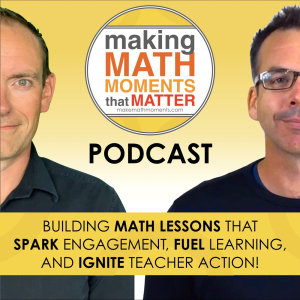
Apply to be a Featured Interview Guest
Book a Mentoring Moment Coaching Call
Are You an Official Math Moment Maker?
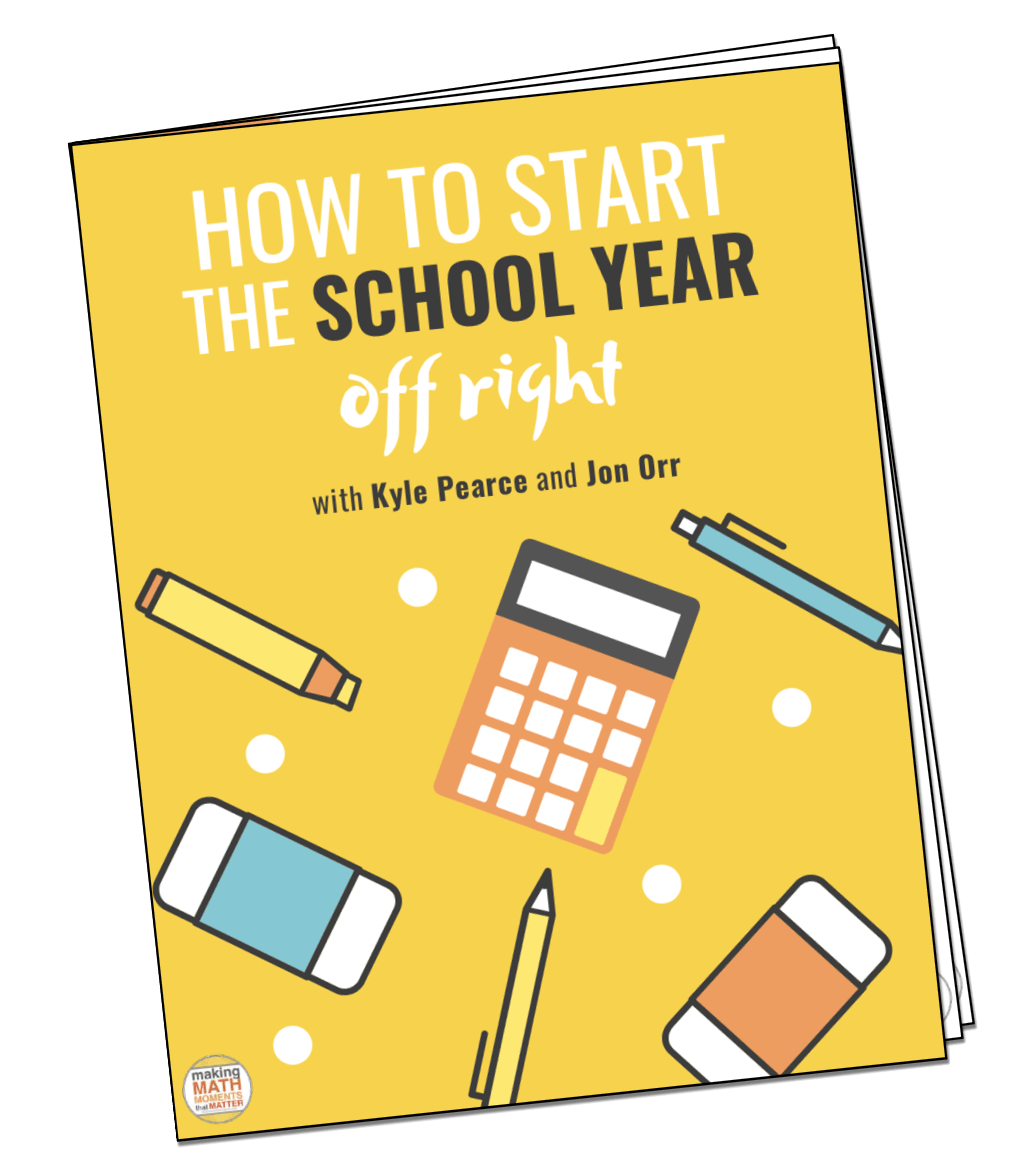
FULL TRANSCRIPT
Hey there, Beth, welcome to the Making Math Moments That Matter podcast.
This is a long time coming. You know, we’ve been chatting, meeting, planning, brainstorming, strategizing, and doing work for a good chunk of time now. We want to tell your story. We want to get a sense of where you were, where you are now, and where you want to go.
So before we dig into your story in the district you work for and the math journey you’ve been on, do our listeners a favor—tell us a little bit about where you are, what your role is in math, and we’ll take it from there.
John, I’m excited to be here.
I am the Math and Science Director in Jeffco, Colorado, the second-largest district in Colorado, with 75,000 students. Stepping into this role, it was really a gift to have some of the tools that Making Math Moments had created, particularly the district-level assessments.
Those gave us ideas as I was coming into a new role—helping me understand the landscape, identify strengths in our current math instruction, and determine areas of challenge. We wanted to focus on high-leverage areas to concentrate our efforts. We don’t have a huge team, but we do have a huge district, and we’re trying to scale a new curriculum across three cohorts of schools in three years, which is a big undertaking.
Yeah, big charge.
So, Beth, before we get into that story, one of the questions we ask every guest on the podcast is about their math moments. When I say math class, what images, experiences, or memories pop into your mind—things that have stuck with you over the years?
It can be positive or negative. We encourage guests to share the first memory that comes to mind because often, that’s the one that had a real impact, for better or worse.
I think back to when I was a math teacher. I taught third grade and second grade. My principal decided to departmentalize, so I taught math and science, and my partner teacher handled English Language Arts.
I was using a curriculum at the time, but I also started integrating some math tasks and experimenting with flipping the triangle. Luckily, I had a leader who valued shifting the thinking onto students—allowing them to grapple with problems.
She asked me to demonstrate one of these lessons for the whole school. It was invigorating but kind of scary. But I really believed in it, and I started seeing good results—changes in my classroom data and students being excited about figuring things out. That experience stuck with me and led me to continue learning more on that path.
How did that experience shape the work you’re doing now in your leadership role?
It showed me the potential of professional development and the importance of providing opportunities for teachers to continuously learn, grow, and refine their craft.
In teacher training programs, we don’t always get the depth of knowledge we need to drive learning and engage students. Now, in my role, I have the opportunity to provide those learning opportunities so that educators can have their own aha moments in their classrooms.
Rewinding a few years, when you were providing professional development, what were some of the things that made you realize you needed to reach out to Making Math Moments for support in Jeffco? What were the challenges?
I believe in the power of a strong vision. I started asking people, What’s the vision for mathematics in our district? What do we believe about math? And I got several different answers—ideas from books people had read, different training experiences—but we didn’t have a unified set of big rocks to guide us.
I knew that if we could define those big rocks, we could focus our efforts and start making real progress. Working with Making Math Moments, we engaged multiple stakeholders—teachers, leaders, and coaches—to have conversations about what really matters.
We asked: What do we want students to think and feel about math? What do we want them to say about their math experience?
For people listening who are also thinking about this, what’s one of your big rocks?
One of our big rocks is Know the Mathematics. We want students to experience grade-level instruction. We’re prioritizing the internalization of math units and lessons, which is crucial when adopting a new curriculum. But beyond that, we want to deepen teachers’ mathematical understanding so they can anticipate student strategies, respond effectively, and give meaningful feedback in the moment.
Before identifying those big rocks, what was professional development like? How were things structured before you had clarity on vision and priorities?
There were some great things happening—connected to books people had read and practices like the Five Practices for Orchestrating Productive Mathematics Discussions and the Eight Effective Math Practices. But it was a lot.
I’d experienced this in my previous district as well, where principals would attend training on aspirational ideas, but then struggle to implement them with limited time and capacity. Narrowing our focus helped us get on the same page and integrate initiatives into existing work, rather than feeling like we were adding one more thing.
Your team has done a fabulous job establishing a clear vision and action plan. What were some key benefits when you brought the team together to do this work?
It was both fun and challenging. It took about three or four months to land on our final vision. We had multiple iterations and gathered feedback from various stakeholders. But now that we have our vision, it’s so powerful.
I was just in classrooms yesterday, and I remember we debated whether to include the word joyful in our vision. But when I was in those classrooms, I felt the joy of doing mathematics. It’s changing how we think about kids’ learning, and it’s having a real impact.
What was the hardest part of implementing measurement systems to track progress?
You really have to start planning in the spring before the next school year. By August, it’s too late. We needed to structure learning walks, develop aligned tools, and ensure alignment with both the math team’s and district’s priorities.
Now, schools appreciate the alignment because they don’t feel like they’re being pulled in different directions. Everyone is rowing in the same direction.
What are you focusing on for next year?
Now that all three cohorts are using the new resource, we want to close the loop on the teaching and learning cycle by strengthening end-of-unit assessment analysis.
Our curriculum doesn’t spiral as much, so we need structured time to reflect on student progress and adjust accordingly.
What advice would you give to a new math leader designing an improvement plan?
Go slow to go fast.
Take time to understand the landscape—identify strengths and areas for growth.
Create a plan with stakeholders, not just for them, so there’s buy-in at all levels.
And celebrate wins. Capture videos, highlight great work from teachers and leaders, and share those successes so others can see and learn from them.
Capturing successes seems underutilized. Why is that so important?
As leaders, we want to know at the end of the year that our planning, structure, and support had an impact.
We often feel like we made progress, but we need evidence—comments from teachers, short videos, student engagement moments, lessons we’ve observed.
If we have those, we can see the progress. Otherwise, we risk starting over with new initiatives that can feel disjointed to teachers.
The key is defining what success looks like, keeping an eye out for it, and documenting it. That way, at the end of the year, we’re not just guessing—we know we’re making a difference.
Any final thoughts?
No, just a big thank you. I really appreciate all the time, thought, and care you’ve put into supporting our team. The resources and coaching have been incredibly helpful.
Our pleasure!
Thanks For Listening
- Book a Math Mentoring Moment
- Apply to be a Featured Interview Guest
- Leave a note in the comment section below.
- Share this show on Twitter, or Facebook.
To help out the show:
- Leave an honest review on iTunes. Your ratings and reviews really help and we read each one.
- Subscribe on iTunes, Google Play, and Spotify.
DOWNLOAD THE 3 ACT MATH TASK TIP SHEET SO THEY RUN WITHOUT A HITCH!
Download the 2-page printable 3 Act Math Tip Sheet to ensure that you have the best start to your journey using 3 Act math Tasks to spark curiosity and fuel sense making in your math classroom!
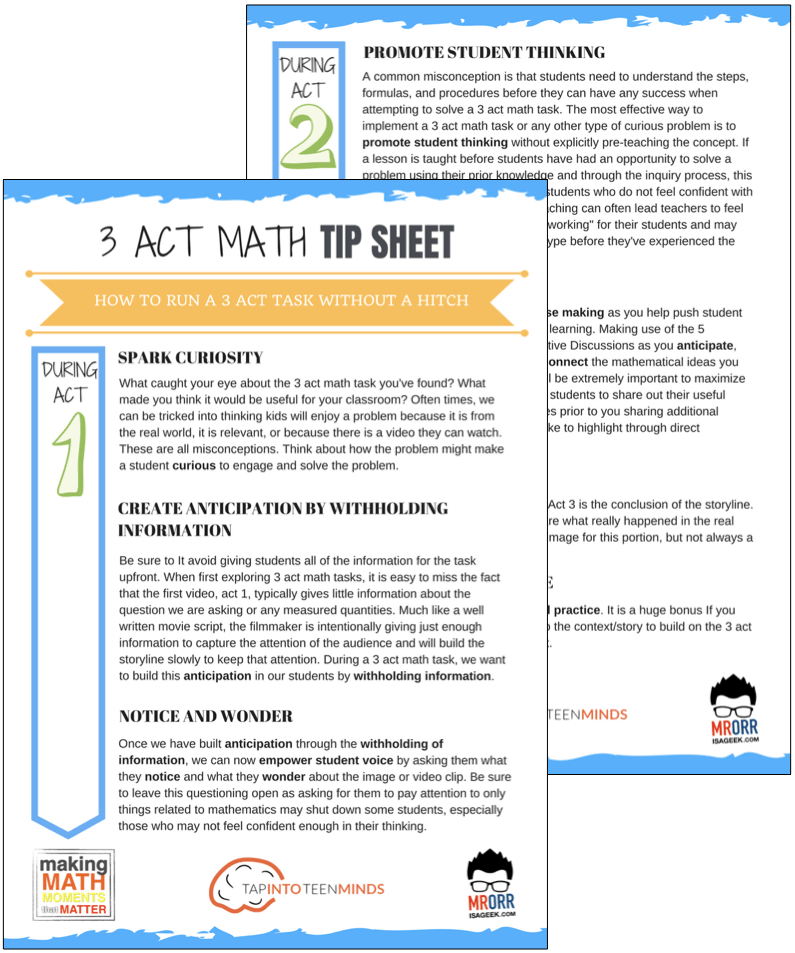
LESSONS TO MAKE MATH MOMENTS
Each lesson consists of:
Each Make Math Moments Problem Based Lesson consists of a Teacher Guide to lead you step-by-step through the planning process to ensure your lesson runs without a hitch!
Each Teacher Guide consists of:
- Intentionality of the lesson;
- A step-by-step walk through of each phase of the lesson;
- Visuals, animations, and videos unpacking big ideas, strategies, and models we intend to emerge during the lesson;
- Sample student approaches to assist in anticipating what your students might do;
- Resources and downloads including Keynote, Powerpoint, Media Files, and Teacher Guide printable PDF; and,
- Much more!
Each Make Math Moments Problem Based Lesson begins with a story, visual, video, or other method to Spark Curiosity through context.
Students will often Notice and Wonder before making an estimate to draw them in and invest in the problem.
After student voice has been heard and acknowledged, we will set students off on a Productive Struggle via a prompt related to the Spark context.
These prompts are given each lesson with the following conditions:
- No calculators are to be used; and,
- Students are to focus on how they can convince their math community that their solution is valid.
Students are left to engage in a productive struggle as the facilitator circulates to observe and engage in conversation as a means of assessing formatively.
The facilitator is instructed through the Teacher Guide on what specific strategies and models could be used to make connections and consolidate the learning from the lesson.
Often times, animations and walk through videos are provided in the Teacher Guide to assist with planning and delivering the consolidation.
A review image, video, or animation is provided as a conclusion to the task from the lesson.
While this might feel like a natural ending to the context students have been exploring, it is just the beginning as we look to leverage this context via extensions and additional lessons to dig deeper.
At the end of each lesson, consolidation prompts and/or extensions are crafted for students to purposefully practice and demonstrate their current understanding.
Facilitators are encouraged to collect these consolidation prompts as a means to engage in the assessment process and inform next moves for instruction.
In multi-day units of study, Math Talks are crafted to help build on the thinking from the previous day and build towards the next step in the developmental progression of the concept(s) we are exploring.
Each Math Talk is constructed as a string of related problems that build with intentionality to emerge specific big ideas, strategies, and mathematical models.
Make Math Moments Problem Based Lessons and Day 1 Teacher Guides are openly available for you to leverage and use with your students without becoming a Make Math Moments Academy Member.
Use our OPEN ACCESS multi-day problem based units!
Make Math Moments Problem Based Lessons and Day 1 Teacher Guides are openly available for you to leverage and use with your students without becoming a Make Math Moments Academy Member.
Partitive Division Resulting in a Fraction
Equivalence and Algebraic Substitution
Represent Categorical Data & Explore Mean
Downloadable resources including blackline masters, handouts, printable Tips Sheets, slide shows, and media files do require a Make Math Moments Academy Membership.
ONLINE WORKSHOP REGISTRATION
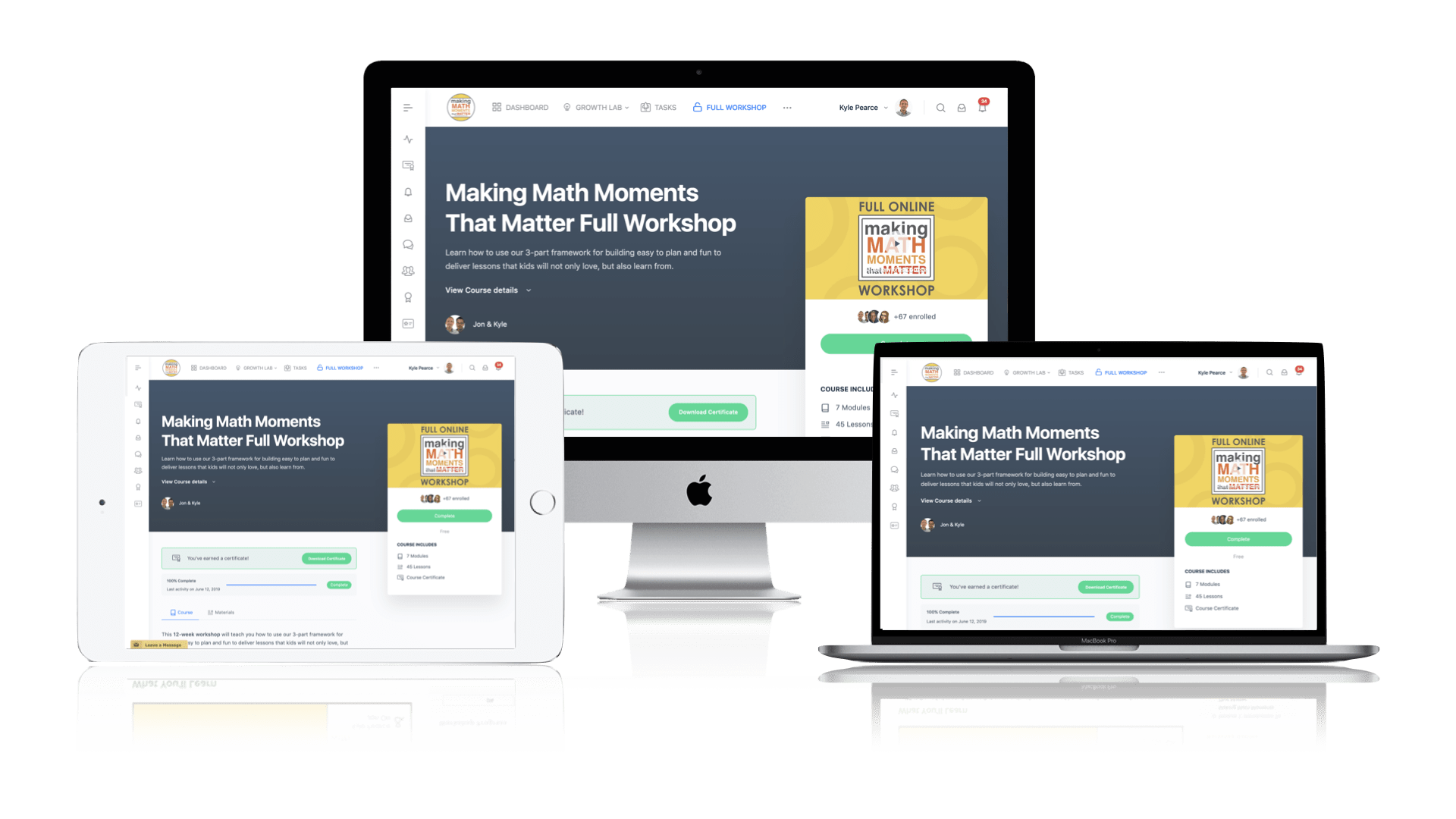
Pedagogically aligned for teachers of K through Grade 12 with content specific examples from Grades 3 through Grade 10.
In our self-paced, 12-week Online Workshop, you'll learn how to craft new and transform your current lessons to Spark Curiosity, Fuel Sense Making, and Ignite Your Teacher Moves to promote resilient problem solvers.
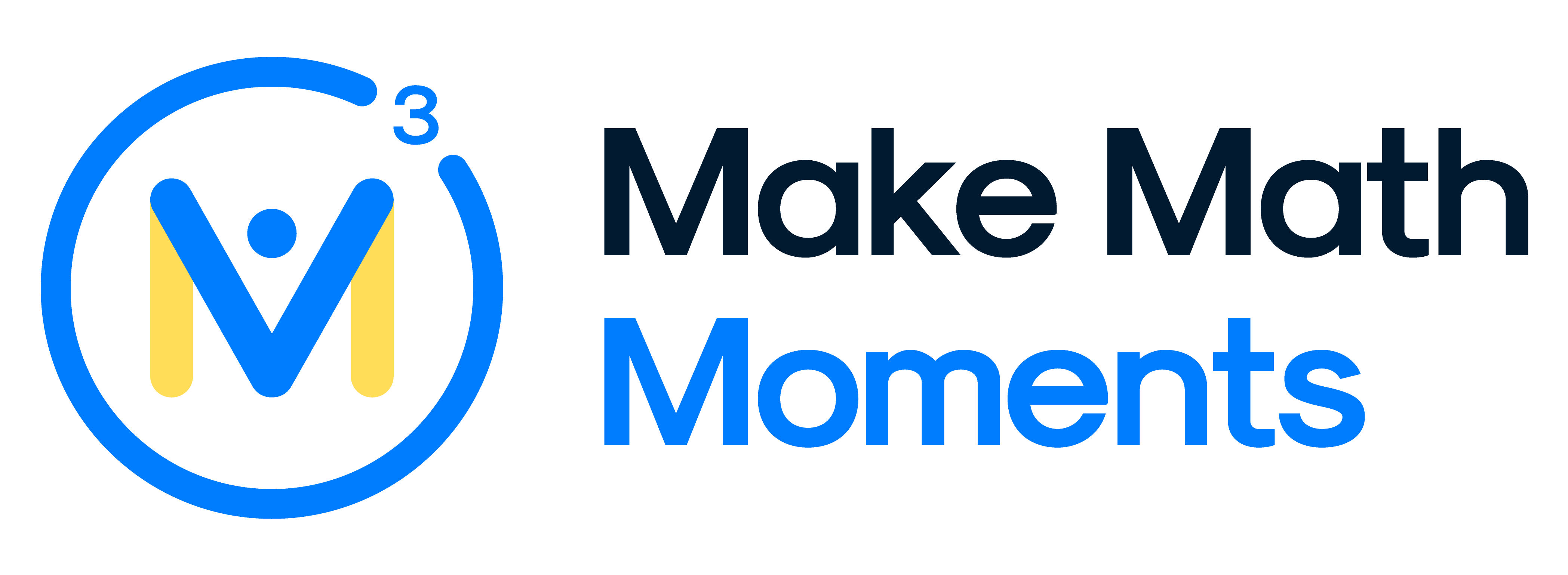



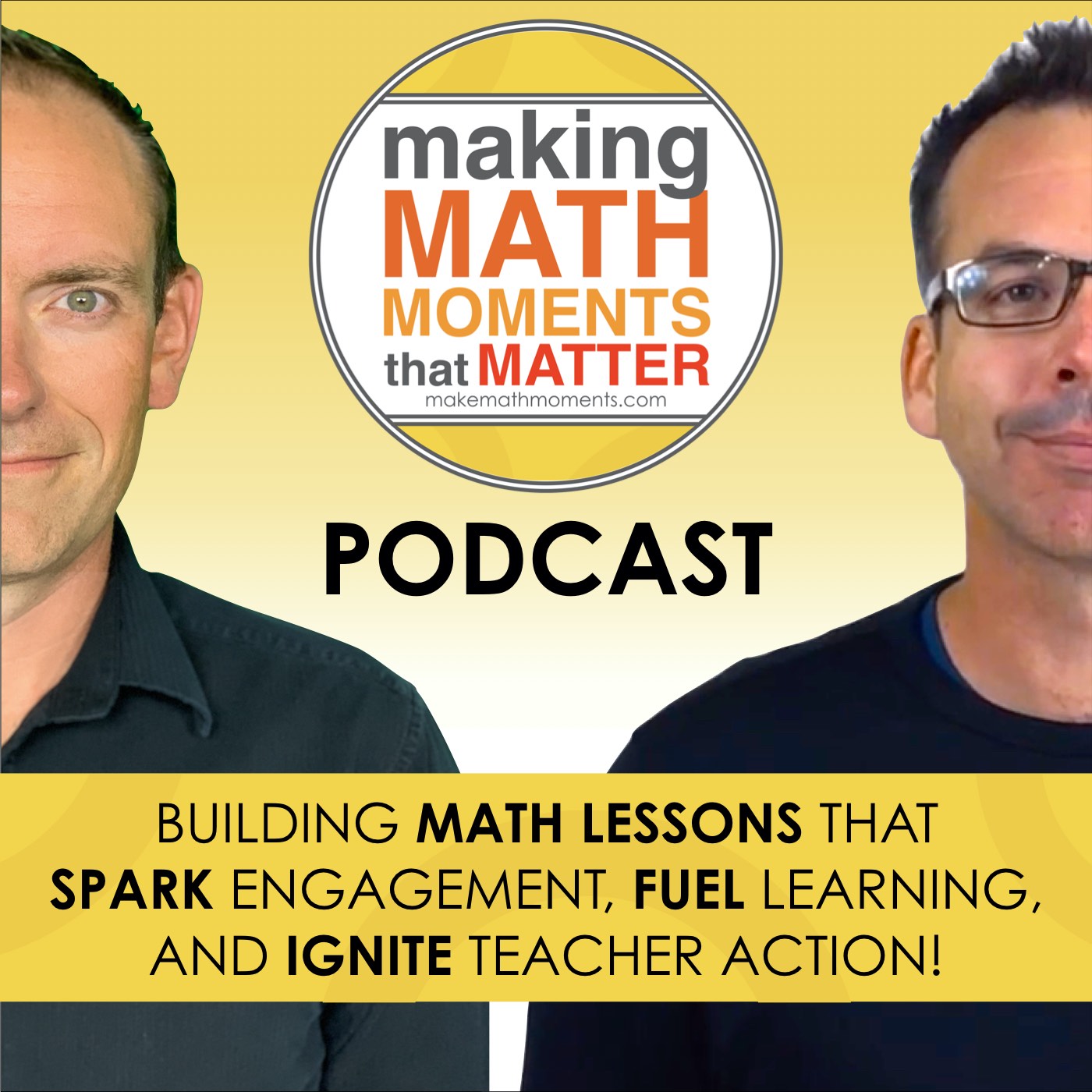
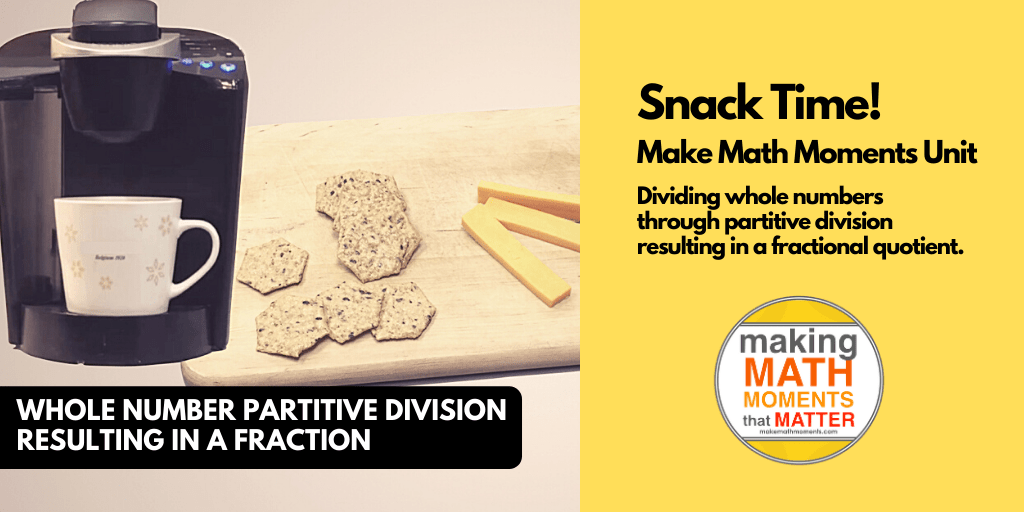
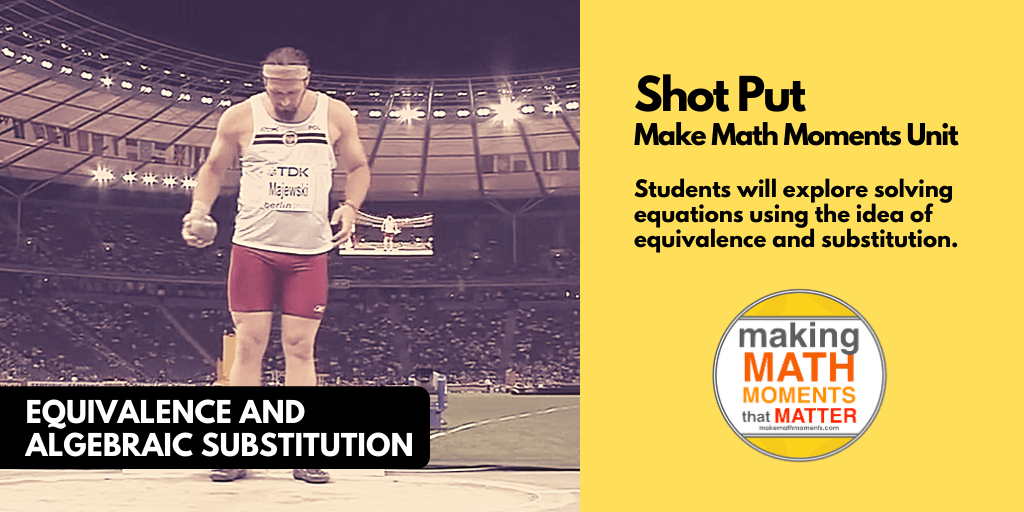
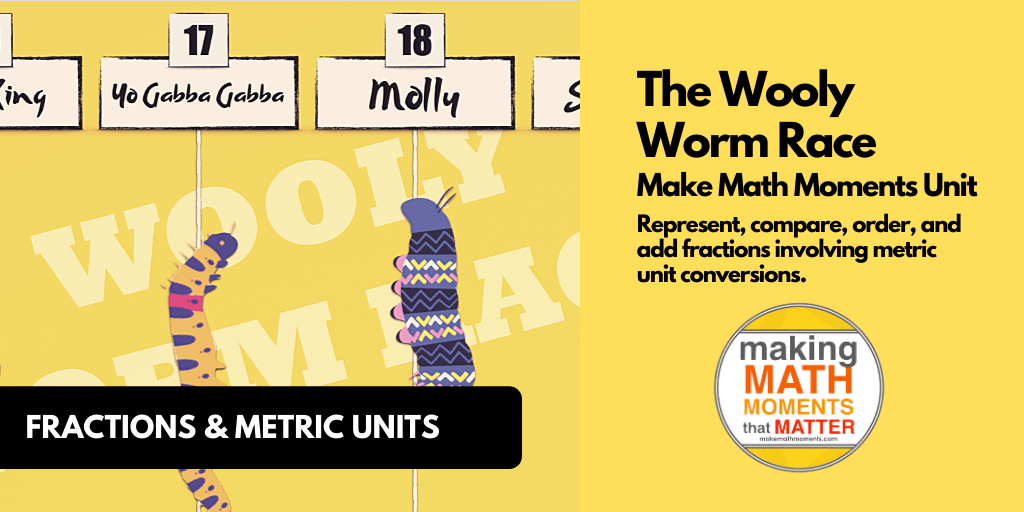
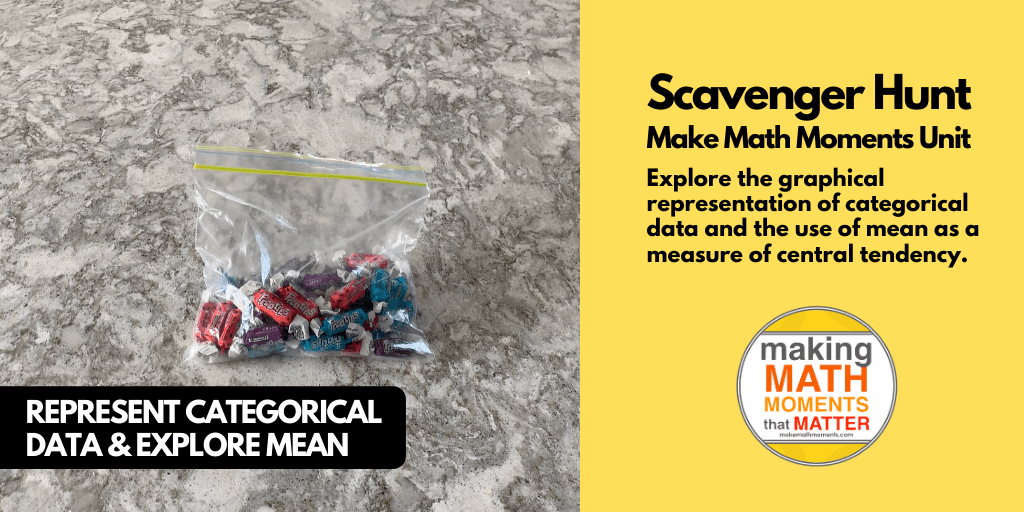
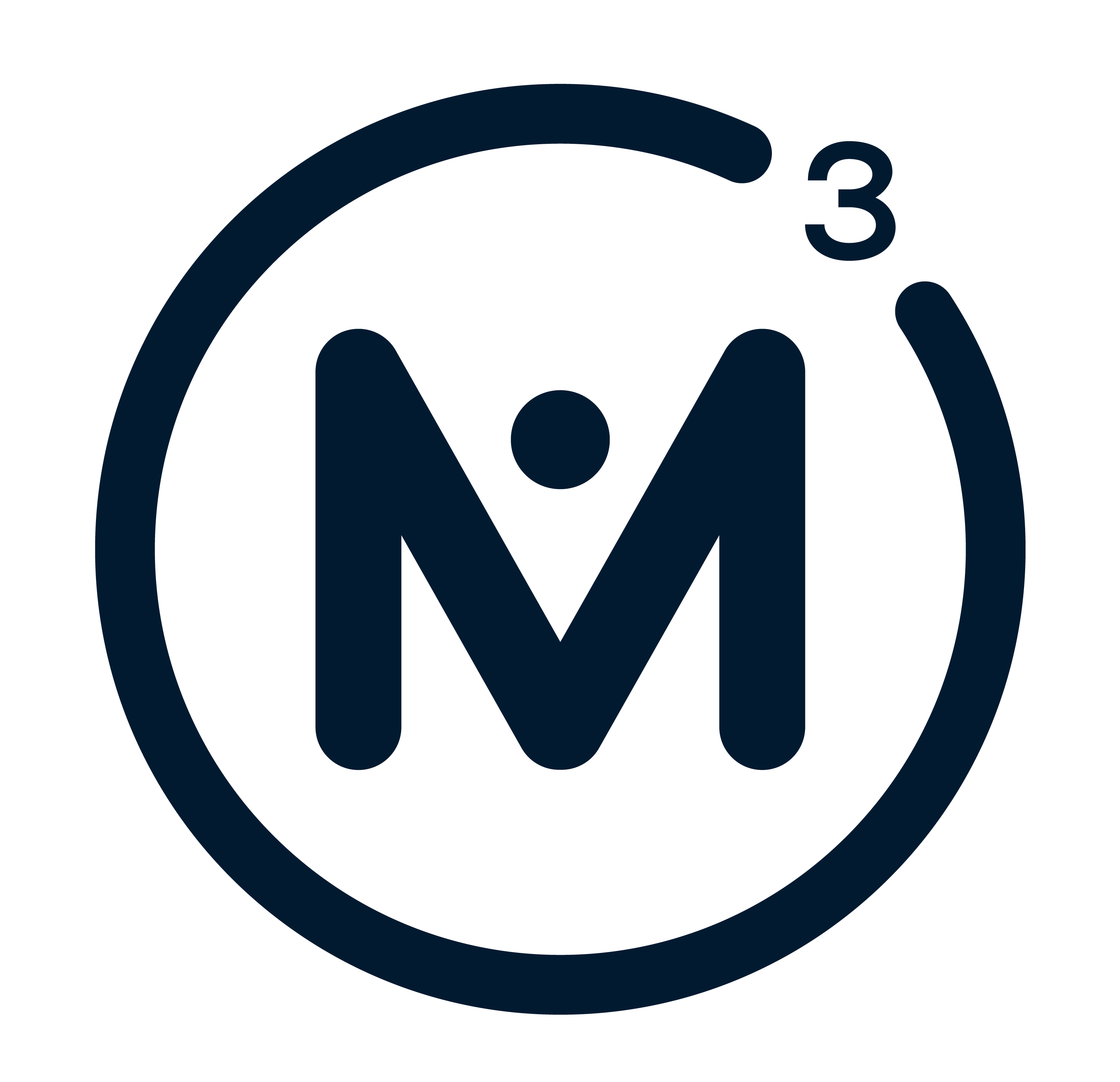
0 Comments